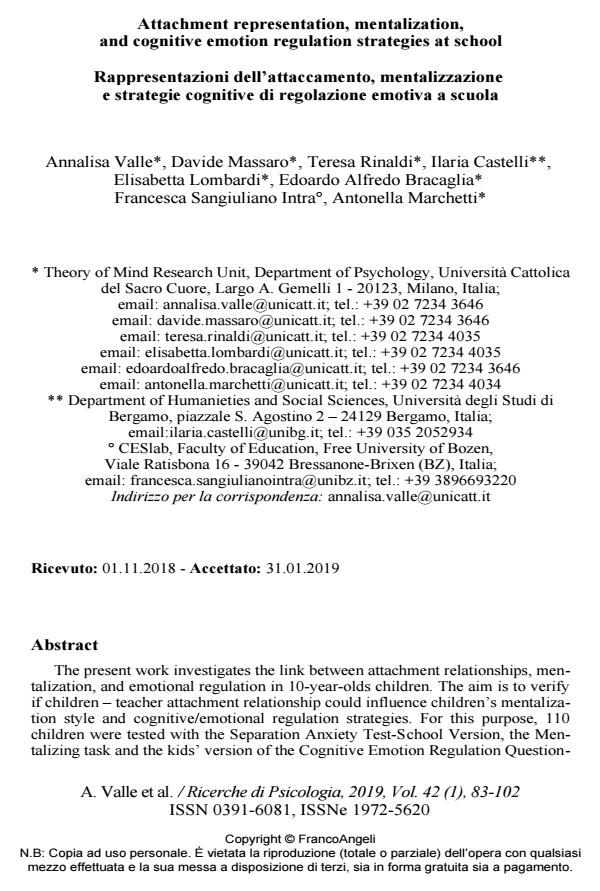Attachment representation, mentalization, and cognitive emotion regulation strategies at school
Titolo Rivista RICERCHE DI PSICOLOGIA
Autori/Curatori Annalisa Valle, Davide Massaro, Teresa Rinaldi, Ilaria Castelli, Elisabetta Lombardi, Edoardo Alfredo Bracaglia, Francesca Sangiuliano Intra, Antonella Marchetti
Anno di pubblicazione 2019 Fascicolo 2019/1
Lingua Inglese Numero pagine 20 P. 83-102 Dimensione file 220 KB
DOI 10.3280/RIP2019-001006
Il DOI è il codice a barre della proprietà intellettuale: per saperne di più
clicca qui
Qui sotto puoi vedere in anteprima la prima pagina di questo articolo.
Se questo articolo ti interessa, lo puoi acquistare (e scaricare in formato pdf) seguendo le facili indicazioni per acquistare il download credit. Acquista Download Credits per scaricare questo Articolo in formato PDF

FrancoAngeli è membro della Publishers International Linking Association, Inc (PILA)associazione indipendente e non profit per facilitare (attraverso i servizi tecnologici implementati da CrossRef.org) l’accesso degli studiosi ai contenuti digitali nelle pubblicazioni professionali e scientifiche
The present work investigates the link between attachment relationships, mentalization, and emotional regulation in 10-year-olds children. The aim is to verify if children - teacher attachment relationship could influence children’s mentalization style and cognitive/emotional regulation strategies. For this pur-pose, 110 children were tested with the Separation Anxiety Test-School Version, the Mentalizing task and the kids’ version of the Cognitive Emotion Regulation Questionnaire. The results show that Self-Reliance component of the attachment representation with teacher predicts both the negative scale of mentalization and the propensity to use the emotional regulation strategy of "Positive Refocusing". Likewise, the Avoidance scale and the Total scale of the Separation Anxiety Test-School Version also influence the use of the cognitive emotion regulation strategy "Putting into Perspective" and of "Positive Refocusing,- respectively. Results are discussed within the theoretical framework of multiple attachment theory, con-firming the hypothesis that affective relationships with professional caregivers - namely school teachers - play an important role in constructing self-representation and the abilities to regulate emotions in stressful situations.
Il presente lavoro indaga il legame tra relazione di attaccamento, mentalizza-zione e regolazione emotiva in bambini di dieci anni. In particolare, si intende ve-rificare se la rappresentazione dell’attaccamento con l’insegnante influenzi lo stile di mentalizzazione e le strategie cognitive di regolazione emotiva utilizzate dai bambini di questa età. A questo scopo, a 110 bambini sono stati somministra-ti il Separation Anxiety Test - versione scuola, il Mentalizing task e il CERQ -kids. I risultati mostrano che la componente di fiducia in sé della rappresentazione dell’attaccamento con l’insegnante predice sia il punteggio alla scala negativa della mentalizzazione, sia la propensione ad utilizzare la strategia di regolazione emotiva della "Rifocalizzazione positiva". Allo stesso modo, la scala di evita-mento e quella totale relative alla rappresentazione dell’attaccamento con l’insegnante influenzano l’utilizzo rispettivamente della strategia di regolazione emotiva della "Modifica della prospettiva" e della "Rifocalizzazione positiva". I risultati sono discussi alla luce della teoria degli attaccamenti multipli, a confer-ma dell’ipotesi che anche relazioni affettive con i caregiver professionali, quali gli/le insegnanti, giochino un ruolo importante nella costruzione della rappresen-tazione di sé e delle proprie abilità nel regolare le emozioni in situazioni stressanti.
Parole chiave:Attaccamento, stili di mentalizzazione, regolazione emoti-va, scuola, relazione bambino-insegnante.
- The Mentalized Affectivity Scale (MAS): Development and validation of the Italian version Teresa Rinaldi, Ilaria Castelli, Andrea Greco, David M. Greenberg, Elliot Jurist, Annalisa Valle, Antonella Marchetti, Frantisek Sudzina, in PLOS ONE /2021 pp.e0249272
DOI: 10.1371/journal.pone.0249272 - Teacher-student attachment relationship, variables associated, and measurement: A systematic review Laura García-Rodríguez, Concha Iriarte Redín, Charo Reparaz Abaitua, in Educational Research Review 100488/2023 pp.100488
DOI: 10.1016/j.edurev.2022.100488 - Do educators matter? Associations between caregivers’ mentalization and preschoolers’ attachment, social emotional development and theory of mind Cecil Mata López, María Pía Santelices Álvarez, Alvaro Vergés Gómez, in Early Child Development and Care /2022 pp.233
DOI: 10.1080/03004430.2020.1755664 - The representation of child–parent relation: validation of the Italian version of the child–parent relationship scale (CPRS-I) Teresa Rinaldi, Ilaria Castelli, Nicola Palena, Andrea Greco, Robert Pianta, Antonella Marchetti, Annalisa Valle, in Frontiers in Psychology 1194644/2023
DOI: 10.3389/fpsyg.2023.1194644 - Mentalization and attachment in educational relationships at primary school Annalisa Valle, Teresa Rinaldi, Andrea Greco, Robert Pianta, Ilaria Castelli, Antonella Marchetti, in RICERCHE DI PSICOLOGIA 1/2022 pp.1
DOI: 10.3280/rip2022oa13226 - The Risk-Taking and Self-Harm Inventory for Adolescents: Validation of the Italian Version (RTSHIA-I) Annalisa Valle, Giulia Cavalli, Laura Miraglia, Edoardo Alfredo Bracaglia, Peter Fonagy, Cinzia Di Dio, Antonella Marchetti, in Behavioral Sciences /2023 pp.321
DOI: 10.3390/bs13040321 - Humanity in Psychology Antonella Marchetti, Edoardo Alfredo Bracaglia, pp.179 (ISBN:978-3-031-30639-6)
- Attachment, emotion regulation, and burnout among university students: a mediational hypothesis Hugo Marques, Rute Brites, Odete Nunes, João Hipólito, Tânia Brandão, in Educational Psychology /2023 pp.344
DOI: 10.1080/01443410.2023.2212889
Annalisa Valle, Davide Massaro, Teresa Rinaldi, Ilaria Castelli, Elisabetta Lombardi, Edoardo Alfredo Bracaglia, Francesca Sangiuliano Intra, Antonella Marchetti, Attachment representation, mentalization, and cognitive emotion regulation strategies at school in "RICERCHE DI PSICOLOGIA " 1/2019, pp 83-102, DOI: 10.3280/RIP2019-001006